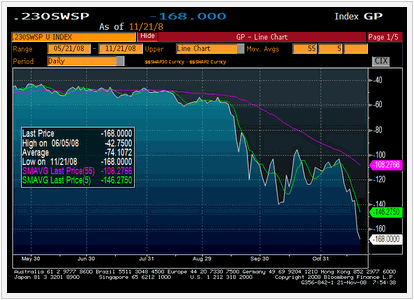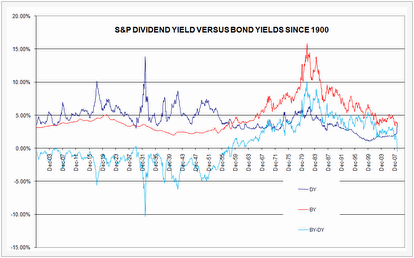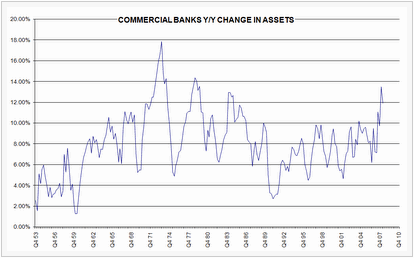Wow.
Just when you thought that Team 850 had managed to contain equity weakness, they pull their bid and stocks go down like a lead balloon. Yesterday’s price action was frankly farcical, as Spoos caught a bid on news of a bilateral deal for the automakers….only to get cratered when news subsequently emerged that no deal will be passed any time in the foreseeable future.
CORRECTION: Yesterday in this space, Macro Man made some non-negative comments about the US Congress. This should have read “They’re all a bunch of muppets.” He regrets the error.
In any event, this was a particularly painful sell-off. While Macro Man was/is a strategic equity bear, he had expected to see a rally to sell into. As such, he has watched his view pan out without having a position (and therefore, a profit.) Very frustrating indeed.
The ruptures in fixed income markets alluded to yesterday picked up a significant head of steam, as the back end of the US curve engaged in what can only be called an uber-rally. 30 year Treasury yields fell by more than 40 bps….and they lagged 30 year swap yields by more than 25 bps! We have seen this movie before in Europe, with exotic interest rate structures blowing up and causing unprecedented volatility (and inversion) in swap curves. Needles to say, the movie doesn’t end happily….though at least the US version won’t be punctuated by a rate hike next month.
We are now at the point where the pricing of certain fixed-income markets appears to defy all rationality, and indeed belief. The chart below shows the US 2-30 swap spread curve, which compares 2 year swap spreads to 30 year swap spreads. An inversion shows that the environment is distressed- i.e., that bank credit is less desirable in the near term (2 years) than the longer term (30 years.) As you can see, despite 2 year swap spreads coming back in, the 2-30 swap curve has inverted massively. That’s not good news.
One theme that’s starting to get quite a bit of airtime to justify a bullish stance on equities is attraction of the dividend cover in the US. Incredibly (to anyone under the age of about 70), the current dividend yield of the S&P 500 is now higher than that of the 10 year Treasury bond. This is supportive of stocks, the thinking goes, because you get paid to hold them relative to bonds!
Perhaps, but there are two pretty good reasons why it would be very dangerous indeed to use this as a market-timing tool…or even a valuation device. The first, of course, is that a dividend paid last quarter will not necessarily be paid next quarter. Particularly in this uncertain environment, one in which earnings expectations remain too high, Macro Man would expect the realized dividend stream over the next twelve months to be less than the trailing divvy yield indicated on your Bloomberg screen.
More interestingly, those dividend yields need to be volatility adjusted. In case you hadn’t noticed, equity volatility has gone up a bit recently. A 4% dividend yield on a 12% vol index isn’t quite the same as a 4% yield on a 80% vol index. Hell, just ask the holders of structured credit turds how attractive their yields are!
In seriousness, this issue of volatility and risk premia has historically been an important one. From the beginning of the 20th century until the late 1950’s, the SPX dividend yield stayed well above bond yields. It was only in 1959 (according to data from Robert Shiller at Yale) that the two yields crossed over, a relationship that they have held for the ensuing 49 years. But if we are talking about Deporession-style economic and market conditions…doesn’t it make sense that the dividend yield/bond yield relationship reverts to type as well? Are equities not something of a damaged asset, as the business model of earnings growth funded by leverage is discredited?
Would it be that bad, or even surprising, if we reverted to a world where dividends explain a greater proportion of equity returns, and price appreciation less? It’s certainly food for thought.
In any event, US banks are once again coming under pressure, with the once-mighty Citi looking like it’s in trouble. Rumours of a merger (more on this below) are circulating throughout the market today, which have given futures a bit of a bounce. A number of punters that Macro Man speaks to are suggesting that banks now look cheap and worth a flutter from the long side.
In response, Macro Man asks them to have a look at the chart below. It is lagging, coming as it does from the Fed’s flow of funds data- the last update was for Q2. And it is macro data- circumstances may be different for individual institutions. But insofar as the theme of 2008 has been “the great de-leveraging”, it must be something of a concern that as of Q2, commercial banks’ asset growth was a) still double digits, y/y, and b) still near the highs. Worrisome stuff, as it suggests still more pain in the pipeline.
Finally, Macro Man has a few quick-hit observations/tid-bits about banks and the market in general:
* Apparently, nearly 40% of the companies in the SPX no longer qualify for inclusion in the index. The S&P 314 doesn’t quite have the same ring, does it?
* There are only 9 stocks in the S&P 500 that are positive y-t-d.
* Goldman Sachs is now below its IPO price in 1999 (and waaaayyyyyyy below its capital raise offering price in September.) Hank Paulson hasn’t done much right, but getting out of GS stock at ~$200 tax free was a sensational trade.
* Citigroup’s market cap as of yesterday’s close was $26 billion. Assuming headcount were reduced to 300,000 today…..that would still value each employee at only $86,666. Still, it could be worse…GM’s market cap only values its workers at $6,578 a head…which is close to their hourly wage.
* Although Macro Man cannot verify this, apparently UBS stock is now trading at a lower price than a Big Mac in Zurich. Attention UBS employees: if your boss tells you that this year’s bonus will be a “whopper”, that’s not necessarily good news.
* Finally, in case you haven’t heard it, the hot rumour has Citigroup merging with Goldman imminently. Apparently the new firm will be called “Sachs and the Citi”.
- Bulenox: Get 45% to 91% OFF ... Use Discount Code: UNO
- Risk Our Money Not Yours | Get 50% to 90% OFF ... Use Discount Code: MMBVBKSM
Disclaimer: This page contains affiliate links. If you choose to make a purchase after clicking a link, we may receive a commission at no additional cost to you. Thank you for your support!





Leave a Reply